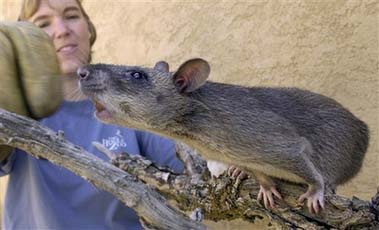

Famous Cases | Historical Tales | Vampires | Zombies
 |  |
Famous Cases | Historical Tales | Vampires | Zombies |
 |
| A Gambian Rat |
All 18 of the animals were carted away for research.
Darin Carroll kept a watchful eye on that dawn mission at Florida's Grassy Key Island. Carroll is no ordinary G-man. He's a disease hunter determined to stop the next outbreak.
Carroll works for the Centers for Disease Control and Prevention, and for three years he has painstakingly tracked the journey of Gambian rats from their African homeland, through the exotic pet trade, and to U.S. homes.
His quest is to prove what many scientists suspect: that African rodents imported as pets caused a monkeypox outbreak in the Midwest in 2003 that sickened dozens of adults and children with a virus related to smallpox. Scientists suspect Gambian rats may play a role.
Similar outbreaks have occurred in Africa.
While no one died from the U.S. outbreak, it sent warning alarms about the potential dangers of importing exotic pets captured in the wild.
Florida and U.S. officials are trying to raise enough money to kill off the Gambian rats that have proliferated on Grassy Key Island, just a few miles from the coast of one of the country's most populous states. The rats were imported to the island a few years ago.
"We tested about 10 to 20 rats a year ago," Carroll explained. "They were never exposed to monkeypox, but we don't know about the others out there."
Carroll's effort underscores one of the realities of animal-borne diseases that jump to humans. Scientists know little about many of the threats, and getting answers usually takes years.
The first time Carroll, 34, came face-to-face with a live Gambian rat was in 2003 when the CDC dispatched him to suburban Chicago during the monkeypox outbreak.
He and a colleague, Mary Reynolds, a CDC epidemiologist, went to the home of an animal dealer who sold pet prairie dogs to some of the people who became ill.
Carroll had been in disease hot zones before. He had searched the dense jungle of eastern Gabon for the animal host of Ebola, a bleeding disease that kills half the people it infects. And he traveled to a rural village near the Ganges river in Bangladesh during an outbreak of Nipah virus to test bats hanging from fruit trees near where children fell ill and died.
Often, Carroll had worn a head-to-toe protective suit when he entered a hot zone. But the animal dealer's home, with its white picket fence and manicured lawn, was unlike any hot zone he had experienced. So he left his "spacesuit" in the car trunk.
He didn't expect to see rodents in the house, nor did he want to alarm the neighbors.
As Carroll walked to the front door, the CDC called: Preliminary lab tests indicated they were dealing with monkeypox.
Monkeypox was first described in 1958 in Denmark when several monkey imports developed lesions. The disease emerged in the Congo in 1970 with sporadic outbreaks over the years, primarily in Central and West Africa. Ten percent of those infected can die, and there is evidence of person-to-person transmission.
Carroll hung up the phone a bit surprised, and walked into the dealer's home.
Prairie dogs skittered in cages on the living room floor. And Gambian rats squatted in cages on the kitchen counter.
"I couldn't believe it," Carroll recalled. "Mary and I looked at the rats, then at each other. We thought we had found the problem. Of course we didn't realize at the time just how much bigger the problem was."
Carroll wondered if he should have worn the spacesuit, but remembered he recently had a shot for smallpox that probably would give some protection.
What Carroll and Reynolds saw was the making of a perfect viral storm: There were different animals under stress in close quarters, creating the opportunity for viruses to jump.
The animals were quarantined. Later, Carroll and another CDC colleague headed to Texas to check on a wholesale exotic pet importer who had brought in about 800 African rodents. Some carried monkeypox.
The importer, Jeffrey Doth, would barely speak at first.
Doth had been busted in 1995 for smuggling five green tree pythons into the country by wrapping them around his waist under a large T-shirt. He was convicted in 2001, ordered to pay a $5,000 fine and sentenced to house arrest for several months.
At the time Doth imported the African rodents, his dealer's license was revoked, Doth told The Associated Press recently in his first interview about the rodents.
Instead, he used the name of a customer's company, he said.
Eventually, Doth warmed to Carroll and let him look at his records.
Doth explained that on April 9, 2003, a large shipment of African rodents — including Gambian rats, dormice and sun squirrels — arrived in Dallas aboard a commercial flight from Ghana. He told Carroll he noticed an "unusually large number of sick and dead animals." Some of the larger animals had consumed the smaller ones.
Carroll said he was surprised to learn that no one ever checked the rodents for disease once they entered the country.
Fish and Wildlife Service inspectors did check the paperwork and look over the cargo. They are not required and not trained to check for disease.
During the monkeypox outbreak, the government banned African rodent imports. But rodents from other parts of the world are still allowed to enter without any disease screening.
In the end, there were dozens of reported cases of monkeypox infection during the U.S. outbreak. At its worst, the disease caused fever, difficulty breathing, painful lesions and, in some, encephalitis.
No one died, but a 10-year-old suffered more than 100 lesions and spent days in a hospital isolation ward. Another person lost part of an eye from a lesion.
Though the outbreak was over, Carroll and others traveled to Ghana a year later to visit the exporter.
They had a long list of wild animal suspects that might be carriers of monkeypox — with Gambian rats near the top. But they needed proof.
Carroll trapped rodents in the same places where they had been captured and exported a year earlier, just before the outbreak.
He sent them back to his lab in Atlanta. A few tested positive for antibodies indicating that at some time in their lives they were exposed to monkeypox or its close relatives.
Before the CDC team left Ghana, the exporter told Carroll that Europe uses strict quarantines to catch diseased wildlife imports, making it expensive for both the exporter and importer.
"That's why he loved to send animals to the United States, because he said there are no rules," Carroll said.